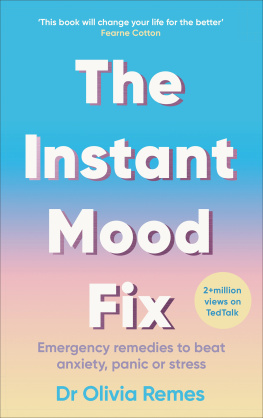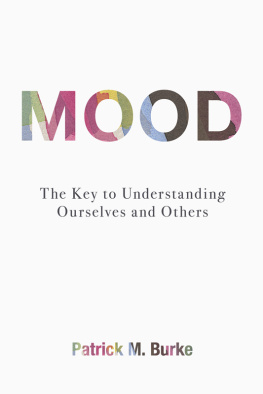EXERCISE FOR MOOD AND ANXIETY
EXERCISE FOR MOOD AND ANXIETY
Proven Strategies for Overcoming Depression and Enhancing Well-Being
Michael W. Otto, Ph.D.
AND
Jasper A. J. Smits, Ph.D.


Oxford University Press, Inc., publishes works that further Oxford Universitys objective of excellence in research, scholarship, and education.
Oxford New York
Auckland Cape Town Dar es Salaam Hong Kong Karachi
Kuala Lumpur Madrid Melbourne Mexico City Nairobi
New Delhi Shanghai Taipei Toronto
With offices in
Argentina Austria Brazil Chile Czech Republic France Greece
Guatemala Hungary Italy Japan Poland Portugal Singapore
South Korea Switzerland Thailand Turkey Ukraine Vietnam
Copyright 2011 by Oxford University Press, Inc.
Published by Oxford University Press, Inc.
198 Madison Avenue, New York, New York 10016
www.oup.com
Oxford is a registered trademark of Oxford University Press
All rights reserved. No part of this publication may be reproduced, stored in a retrieval system, or transmitted, in any form or by any means, electronic, mechanical, photocopying, recording, or otherwise, without the prior permission of Oxford University Press.
Library of Congress Cataloging-in-Publication Data
Otto, Michael W.
Exercise for mood and anxiety: proven strategies for overcoming depression and enhancing well-being / Michael W. Otto, Jasper A.J. Smits.
p. cm.
Includes bibliographical references and index.
ISBN 978-0-19-979100-2
1. Mood (Psychology) 2. Anxiety. 3. Exercise therapy.
4. ExercisePsychological aspects. I. Smits, Jasper A. J. II. Title.
BF521.O88296 2011
615.82dc22
2011010216
9 8 7 6 5 4 3 2 1
Printed in the United States of America on acid-free paper
MWO: To Whitney, for her extraordinary love and warmth
JAJS: To Jill and Stella, for their love and support
ACKNOWLEDGMENTS
We owe gratitude to many people who have helped us complete this project. First among these are international teams of researchers who have documented the mood-enhancing effects of exercise in population-based studies, experimental investigations, clinical studies, meta-analytic comparisons, and review articles. We would also like to thank our collaborators on our own investigations in this area. In particular, our collaborators on research and review articles included Evi Behar, Tim Church, Lynette Craft, Lindsey deBoer, Daniel Galper, Dina Gordon, Tracy Greer, Pamela Handelsman, Bridget Hearon, Kristin Julian, Kate McHugh, Heather Murray, Mark Powers, Katherine Presnell, Georgia Stathopoulou, Candyce Tart, Madhukar Trivedi, Angie Utschig, and Michael Zvolensky. All of these individuals helped expand what is known about the benefits of exercise for mood and anxiety disorders. We would also like to thank Jaime Toussaint, Michelle Capozzoli, Michelle Davis, and Samantha Moshier for their help with drafts of this project. Finally, we want to thank Sarah Harrington, our editor at OUP, for her enthusiasm for this book and her expert help ushering it through the publication process.
CONTENTS
EXERCISE FOR MOOD AND ANXIETY
[1]
ABOUT THIS BOOK
There are many good reasons to reach for this book. If you have been plagued by moodiness, stress, anxiety, or depression, this is the book for you. If you are looking for a more action-based approach to mood management than that afforded by medications or psychotherapy, this is the book to read. If you have tried to exercise regularly and have failed, then this is your book. Why? Because this book is unique in focusing on how you can get yourself to exercise and how to make regular exercise a habit that lasts. This book offers a cutting-edge, research-based approach to integrating exercise into your lifestyleall for the benefit of your mood.
We, the authors have published over 300 research articles on mood and anxiety disorders, and have over 30 years of clinical experience in helping people meet their personal goals. We understand the true nature of motivation. In this book, we provide readers with guidance on what underlies self-control efforts, and how to make the change process easier.
From population-based studies to clinical trials, powerful evidence suggests that exercise interventions can have substantial effects on mood, lifting everyday bad moods and feelings of stress, as well as offering treatment effects for diagnosed depression that rival antidepressant medications. These effects are powerful, and we open by presenting the converging evidence for mood benefits from regular exercise.
But how do you get yourself to exercise, especially when stressed, anxious, or depressed? makes sense out of the common failures in exercise that are reflected in the broader failure of exercise in America over the past several decades. One reason for this failure is the substantial delay between effort and reward when one exercises for the benefit of health or body shape. Sustaining that effort, particularly when stressed, takes Herculean effortas you probably already know. In contrast, when exercising for mood, stress is no longer a barrier to exercise; it is the very reason to exercise.
As part of helping readers adopt a new strategy for exercise and mood goals, challenges the traditional perception of motivation as an inward trait that one must rely on for completing challenging tasks. Rather than looking inward, this chapter asks you to look outward at the actual determinates of motivation. We emphasize the active shifting of ones environment to reduce motivational effort, and we guide readers with rich examples of studies on self-control issues ranging from overeating to what is referred to as effort fatigue. The result is that readers will be informed by the latest in social and clinical psychology research as it impacts motivation for change. You will finish this chapter understanding that reliance on internal feelings of motivation is a recipe for failure, and that alternatives are readily at hand.
Yet, how should you coach yourself around your exercise program? How should you think about your exercise during the day? What are the common thoughts that derail exercise? What should you think about during your exercise? How should you think about your exercise experience after you are done? Drawn from the success of the psychological treatment method known as cognitive therapy, goals and improving well-being. As a result, you will be better prepared to identify and intervene with thoughts that may hinder the adoption and enjoyment of a successful exercise program.
In provides the core features of our exercise prescription. We chose to provide this prescription late in the book, so that our readers would have a full understanding of exercise pitfalls and solutions before initiating an exercise program.
focuses crucial attention on the feel of exercise, and on those things that help individuals get the most out of an exercise session and the mood rewards it brings. The chapter addresses what you should think about during exercise, and how you should direct your attention between the pleasant and unpleasant aspects of physical exertion. We introduce a mindfulness approach to exercise, with the use of mindfulness to promote well-being during exercise, as well as the use of exercise to promote further mindfulness.
Next page










